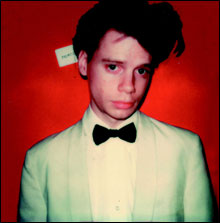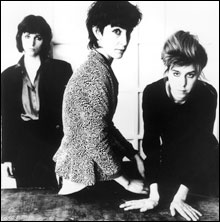 Long before Vice’s cheeky Yes New York compilation, or before Sacramento stoner funk hydra !!! made a career out of channeling Liquid Liquid 24-7, the sounds of the short-lived No Wave movement were always in the air, echoing through the angular, aggressive electro-pulse of bands like Six Finger Satellite, Lightning Bolt, and Scissor Girls, among others.
Long before Vice’s cheeky Yes New York compilation, or before Sacramento stoner funk hydra !!! made a career out of channeling Liquid Liquid 24-7, the sounds of the short-lived No Wave movement were always in the air, echoing through the angular, aggressive electro-pulse of bands like Six Finger Satellite, Lightning Bolt, and Scissor Girls, among others.
It’s hard to remember now, with a Starbucks on every corner and luxury condos going up on the Bowery, but New York City’s East Village was once bombed-out and derelict, a no man’s land of half-empty tenements and even emptier storefronts. What this stark, unrelenting landscape lacked in charm and amenities it made up for in other ways: cheap rent and freedom from the corporate, buttoned-up life going on mere blocks away in midtown Manhattan.
Bands such as Teenage Jesus and the Jerks, Mars, Theoretical Girls, and DNA created music that reflected that, often sounding like the city’s undiluted id. If New Wave was the well-adjusted, bubblegum version of punk, all scrubbed clean and Technicolor-bright, then splinter offshoot No Wave better reflected the city that spawned it — ugly, depressed, crime-ridden New York City.
No musical movement, not even CBGB’s-era first-wave punk, captured the push-and-pull of love/hate — the purity of ambivalence — about modern city living like No Wave did, or with such brutal concision. The anxiety of living in the city was magnified and amplified through cheap speakers — a maelstrom of pure emotional reaction, backed by music that was twitchy and raw and often so unflinchingly intimate as to be unlistenable.
RL Crutchfield, who founded DNA and went on to form Dark Day, sums up No Wave’s aesthetic philosophy: “It was a kind of disassembling of what passed for the time as rock and roll, taking apart the chords, the rhythms, the over-rehearsed quality of it. It needed to be raw and fresh like a newborn baby, screaming its lungs out.”
Sally Young, Jacqui Ham, and Nina Canal of pioneering power-trio Ut, whose music represented a constant tug of war between the primitive and the sensual, pitting low-end assaults with tape loops, hums, and fierce drumming, concur: “No Wave was [about] breaking things down to the raw essential, ignoring rules and inventing new ones.”
Band lineups were also about breaking down rules, with band members often doing double- or even triple-duty in other units at the same time. Ut gave this practice a subtly subversive tweak when they did away with a single focal point completely, preferring instead to switch off instruments and the role of lead singer. Like Ut, many of these bands aimed for, as cultural critic Dan Graham called it, “internal democracy in a non-hierarchical structure.”
 Sally, Jacqui, and Nina of Ut recognize that the experimentation of the past has found new receptivity: “Our openness to the collision of free jazz, blues, rock, funk, avant-garde, and world music is now reflected more widely as people have gotten [more] sophisticated at taking in the merge of sounds and rhythms. There has been a steady education of the mass ear — exposure to cut-ups in hip-hop and sampling has made everyone participate in musique concrète.” All of this has a great deal of resonance for our computer-savvy culture in which most of us own the means to do it ourselves (make the music, design the sleeves, burn the CDs). Anyone can remix, remodel. Says Crutchfield, “When it comes down to it, rock music isn’t about skill, it’s about the need for self-expression. Any kid at home with a craving to do it can do it.”
Sally, Jacqui, and Nina of Ut recognize that the experimentation of the past has found new receptivity: “Our openness to the collision of free jazz, blues, rock, funk, avant-garde, and world music is now reflected more widely as people have gotten [more] sophisticated at taking in the merge of sounds and rhythms. There has been a steady education of the mass ear — exposure to cut-ups in hip-hop and sampling has made everyone participate in musique concrète.” All of this has a great deal of resonance for our computer-savvy culture in which most of us own the means to do it ourselves (make the music, design the sleeves, burn the CDs). Anyone can remix, remodel. Says Crutchfield, “When it comes down to it, rock music isn’t about skill, it’s about the need for self-expression. Any kid at home with a craving to do it can do it.”
No Wave has never sounded as of-the-moment as it does now, thanks to a marked resurgence in bands expanding upon its signature sound (Liars, LCD Soundsystem, Glass Candy, Erase Errata, les Georges Leningrad) and a spate of reissues, the most vital of which is the Holy Grail of No Wave, Brian Eno’s seminal No New York, long out-of-print and much sought-after as the compilation that started it all.
No New York presents No Wave at its most uncompromising. Four bands — Teenage Jesus and the Jerks, James Chance and the Contortions, DNA, and Mars — are represented by four songs each. Pulling no punches, the occasionally intimidating, always remarkable compilation is all sinew and no filler. No wonder that Island, Eno’s label, balked when it heard the music and proceeded to dump the compilation out on its bargain-bin label Antilles. More than 25 years later, this music hasn’t lost its bite or its ability to shock.
Leading the way was Lydia Lunch. Her first order of business was to dismantle punk’s over-reliance on, as she put it, “tired Chuck Berry riffs.” Through her first band Teenage Jesus and the Jerks, she stripped the music as close to the bone as possible, making a minimal, atonal racket as aggressive as it was arresting. (How minimal, you ask? She chucked James Chance out of the band because his saxophone blare was too flowery.)